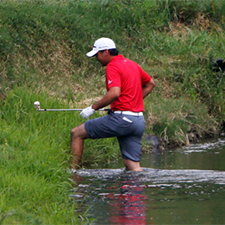During the third round of last week’s PGA Championship, Jason Day hit his tee shot into an area that is all too familiar to many of us golfers, a water hazard. However, he didn’t hit it into the actual water within the lateral water hazard on the 500-yard par-4 second hole. He hit it so far off line that it actually ended up in the thick weeds left of Floyds Fork, a tributary which runs through Valhalla Golf Club. The likelihood that he would actually find the ball, let alone be able to play it, was very slim.
Luckily he had the benefit of on-course reporter David Feherty following his group. Feherty was able to make his way across the creek and began to search for the ball before Jason Day arrived. Under Rule 27-1, the player is entitled to search for his ball for five minutes. However, those five minutes don’t start until the player or his caddie reaches the area where the ball is likely to be. So the time that Feherty began searching by himself was bonus time for the ball to be found. Day’s caddie joined the search for the ball when they arrived on the scene, therefore starting the five minutes allotted for search. Luckily the ball was found within five minutes, so Day had the option of playing the ball as it lies in the lateral water hazard. But what would have been his choices if the ball had not been found within five minutes?
When a ball is not found within five minutes of searching, it is deemed lost. If the ball is lost through the green, a player would only have one option, which would be to return to the spot where they last played from and play under penalty of stroke and distance as prescribed in Rule 27-1. However, if it is known or virtually certain that a ball that has not been found is in a water hazard or lateral water hazard, the player may proceed under any of the available options under Rule 26-1 (Water Hazards). Because this was a red lateral water hazard, the options available to Day were:
a. Proceed under stroke and distance by going back and playing a ball from the teeing ground.
b. Drop a ball behind the water hazard, keeping the point where the ball last crossed the margin of the hazard between him and the flagstick, with no limit to how far back he may drop.
c. (i) Drop a ball outside the water hazard within two club-lengths of and not nearer the hole than the point where the original ball last crossed the margin of the hazard or (ii) a point on the opposite margin of the hazard equidistant from the hole.
(If he would have been in a yellow water hazard, he would have only had options a. and b. available to him.)
After taking his shoes off and rolling his pants up, Day decided to cross the creek and evaluate the lie to determine if he was going to attempt to play the ball as it lies. He decided to give it a shot, so his caddie tossed over his pitching wedge and he extricated the ball out of the hazard, being careful not to ground his club in the hazard (Rule 13-4). Day then put his third shot to about 12 feet for par and was able to sink the putt for an unbelievable 4! So if you ever find yourself in a similar situation, you could attempt to pull off a Jason Day-like miracle. But if you forget to bring your paddle and kayak to the course, the Rules are always there to get you back in play.


